
Edvard Munch was a Norwegian painter. His best known work, The Scream (1893), has become one of Western art's most iconic images.

Oil painting is the process of painting with pigments with a medium of drying oil as the binder. It has been the most common technique for artistic painting on wood panel or canvas for several centuries, spreading from Europe to the rest of the world. The advantages of oil for painting images include "greater flexibility, richer and denser colour, the use of layers, and a wider range from light to dark". But the process is slower, especially when one layer of paint needs to be allowed to dry before another is applied.

Paint is any pigmented liquid, liquefiable, or solid mastic composition that, after application to a substrate in a thin layer, converts to a solid film. It is most commonly used to protect, color, or provide texture. Paint can be made in many colors—and in many different types. Paint is typically stored, sold, and applied as a liquid, but most types dry into a solid. Most paints are either oil-based or water-based and each has distinct characteristics. For one, it is illegal in most municipalities to discard oil-based paint down household drains or sewers. Clean-up solvents are also different for water-based paint than they are for oil-based paint. Water-based paints and oil-based paints will cure differently based on the outside ambient temperature of the object being painted Usually, the object being painted must be over 10 °C (50 °F), although some manufacturers of external paints/primers claim they can be applied when temperatures are as low as 2 °C (35 °F).
Sienna is an earth pigment containing iron oxide and manganese oxide. In its natural state, it is yellowish brown and is called raw sienna. When heated, it becomes a reddish brown and is called burnt sienna. It takes its name from the city-state of Siena, where it was produced during the Renaissance. Along with ochre and umber, it was one of the first pigments to be used by humans, and is found in many cave paintings. Since the Renaissance, it has been one of the brown pigments most widely used by artists.
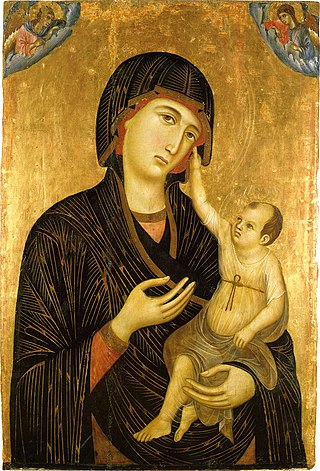
Tempera, also known as egg tempera, is a permanent, fast-drying painting medium consisting of colored pigments mixed with a water-soluble binder medium, usually glutinous material such as egg yolk. Tempera also refers to the paintings done in this medium. Tempera paintings are very long-lasting, and examples from the first century AD still exist. Egg tempera was a primary method of painting until after 1500 when it was superseded by oil painting. A paint consisting of pigment and binder commonly used in the United States as poster paint is also often referred to as "tempera paint", although the binders in this paint are different from traditional tempera paint.

A pigment is a colored material that is completely or nearly insoluble in water. In contrast, dyes are typically soluble, at least at some stage in their use. Generally dyes are often organic compounds whereas pigments are often inorganic compounds. Pigments of prehistoric and historic value include ochre, charcoal, and lapis lazuli.

Gouache, body color, or opaque watercolor is a water-medium paint consisting of natural pigment, water, a binding agent, and sometimes additional inert material. Gouache is designed to be opaque. Gouache has a considerable history, having been used for at least twelve centuries. It is used most consistently by commercial artists for posters, illustrations, comics, and other design work.

Watercolor or watercolour, also aquarelle, is a painting method in which the paints are made of pigments suspended in a water-based solution. Watercolor refers to both the medium and the resulting artwork. Aquarelles painted with water-soluble colored ink instead of modern water colors are called aquarellum atramento by experts. However, this term has now tended to pass out of use.

The Scream is a composition created by Norwegian artist Edvard Munch in 1893. The agonized face in the painting has become one of the most iconic images of art, seen as symbolizing the anxiety of the human condition. Munch's work, including The Scream, would go on to have a formative influence on the Expressionist movement.
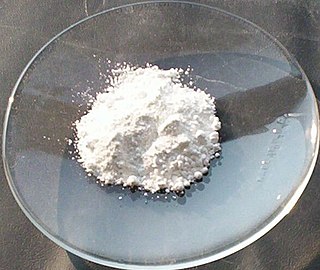
Zinc oxide is an inorganic compound with the formula ZnO. It is a white powder that is insoluble in water. ZnO is used as an additive in numerous materials and products including cosmetics, food supplements, rubbers, plastics, ceramics, glass, cement, lubricants, paints, ointments, adhesives, sealants, pigments, foods, batteries, ferrites, fire retardants, and first-aid tapes. Although it occurs naturally as the mineral zincite, most zinc oxide is produced synthetically.

Oil paint is a type of slow-drying paint that consists of particles of pigment suspended in a drying oil, commonly linseed oil. The viscosity of the paint may be modified by the addition of a solvent such as turpentine or white spirit, and varnish may be added to increase the glossiness of the dried oil paint film. The addition of oil or alkyd medium can also be used to modify the viscosity and drying time of oil paint. Oil paints were first used in Asia as early as the 7th century AD and can be seen in examples of Buddhist paintings in Afghanistan. Oil-based paints made their way to Europe by the 12th century and were used for simple decoration, but oil painting did not begin to be adopted as an artistic medium there until the early 15th century. Common modern applications of oil paint are in finishing and protection of wood in buildings and exposed metal structures such as ships and bridges. Its hard-wearing properties and luminous colors make it desirable for both interior and exterior use on wood and metal. Due to its slow-drying properties, it has recently been used in paint-on-glass animation. The thickness of the coat has considerable bearing on the time required for drying: thin coats of oil paint dry relatively quickly.
Cerulean, also spelled caerulean, is a shade of blue ranging between azure and a darker sky blue.

Lead paint or lead-based paint is paint containing lead. As pigment, lead(II) chromate, lead(II,IV) oxide,, and lead(II) carbonate are the most common forms. Lead is added to paint to accelerate drying, increase durability, maintain a fresh appearance, and resist moisture that causes corrosion. It is one of the main health and environmental hazards associated with paint. Lead paint has been generally phased out of use due to the toxic nature of lead. Alternatives such as water-based, lead-free traffic paint are readily available.
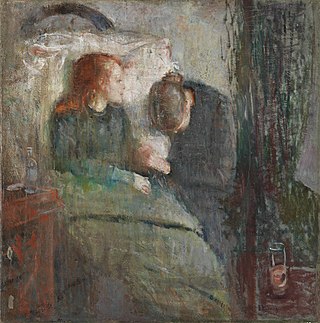
The Sick Child is the title given to a group of six paintings and a number of lithographs, drypoints and etchings completed by the Norwegian artist Edvard Munch between 1885 and 1926. All record a moment before the death of his older sister Johanne Sophie (1862–1877) from tuberculosis at 15. Munch returned to this deeply traumatic event repeatedly in his art, over six completed oil paintings and many studies in various media, over a period of more than 40 years. In the works, Sophie is typically shown on her deathbed accompanied by a dark-haired, grieving woman assumed to be her aunt Karen; the studies often show her in a cropped head shot. In all the painted versions Sophie is sitting in a chair, obviously suffering from pain, propped by a large white pillow, looking towards an ominous curtain likely intended as a symbol of death. She is shown with a haunted expression, clutching hands with a grief-stricken older woman who seems to want to comfort her but whose head is bowed as if she cannot bear to look the younger girl in the eye.

Underdrawing is a preparatory drawing done on a painting ground before paint is applied, for example, an imprimatura or an underpainting. Underdrawing was used extensively by 15th century painters like Jan van Eyck and Rogier van der Weyden. These artists "underdrew" with a brush, using hatching strokes for shading, using water-based black paint, before underpainting and overpainting with oils. Cennino D'Andrea Cennini describes a different type of underdrawing, made with graded tones rather than hatching, for egg tempera.

White lead is the basic lead carbonate 2PbCO3·Pb(OH)2. It is a complex salt, containing both carbonate and hydroxide ions. White lead occurs naturally as a mineral, in which context it is known as hydrocerussite, a hydrate of cerussite. It was formerly used as an ingredient for lead paint and a cosmetic called Venetian ceruse, because of its opacity and the satiny smooth mixture it made with dryable oils. However, it tended to cause lead poisoning, and its use has been banned in most countries.
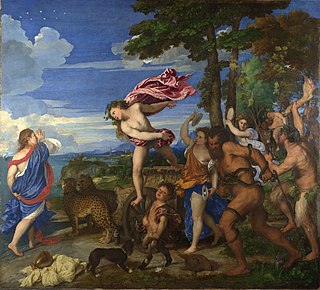
Lead-tin-yellow is a yellow pigment, of historical importance in oil painting, sometimes called the "Yellow of the Old Masters" because of the frequency with which it was used by those famous painters.

Red pigments are materials, usually made from minerals, used to create the red colors in painting and other arts. The color of red and other pigments is determined by the way it absorbs certain parts of the spectrum of visible light and reflects the others. The brilliant opaque red of vermillion, for example, results because vermillion reflects the major part of red light, but absorbs the blue, green and yellow parts of white light.
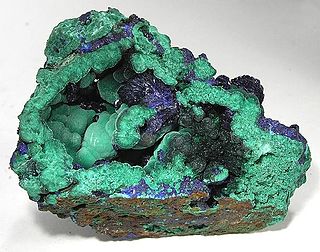
Green pigments are the materials used to create the green colors seen in painting and the other arts. Most come from minerals, particularly those containing compounds of copper. Green pigments reflect the green portions of the spectrum of visible light, and absorb the others. Important green pigments in art history include Malachite and Verdigris, found in tomb paintings in Ancient Egypt, and the Green earth pigments popular in the Middle Ages. More recent greens, such as Cobalt Green, are largely synthetic, made in laboratories and factories.
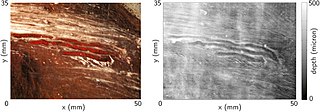
In visual arts, the ground is a prepared surface that covers the support of the picture and underlies the actual painting. Occasionally the term is also used in a broad sense to designate any surface used for painting, for example, paper for watercolor or plaster for fresco.




















